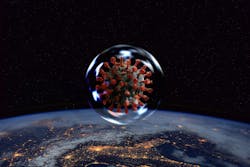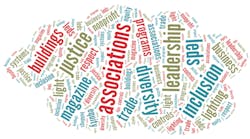Germicidal ultraviolet (UV) technology continues to be a hot topic in the lighting world as the COVID-19 pandemic rages globally, and demand for understanding about disinfection techniques soars. The Lighting Research Center (LRC) at Rensselaer Polytechnic Institute has issued a 55-page report on germicidal UV that spans topics from how UV energy impacts pathogens to hands-on testing of some germicidal UV products. Seoul Semiconductor and the Korea Testing Laboratory said UV LEDs in an HVAC system can deactivate 99% of airborne pathogens. German research institutes and Osram are expanding germicidal UV research.
LRC report
The new LRC report titled “Lighting Answers: UV Disinfection Products” is part of the lab’s National Lighting Product Information Program (NLPIP) that is intended to guide lighting designers to contractors to engineers in specifying effective and energy-efficient lighting products. Development of the report was sponsored by the Lighting Energy Alliance, the McClung Lighting Research Foundation, and the New York State Energy Research and Development Authority (NYSERDA).
The LRC work is very broad starting with the basics of how UV energy deactivates fungicidal, bacterial, and viral pathogens. Much of the focus is on UV-C-band (100–280 nm) energy, but the work covers longer wavelengths as well. The document provides an exhaustive description of types of UV sources available, and the types of system implementations being offered by manufacturers.
There is a detailed section on dosage and germicidal efficacy in the LRC report. There is also some detail on an LRC survey deployed on the germicidal topic last summer that is instructive in terms of the beliefs and expectations of key stakeholders in the lighting industry. And the appendices take a hands-on look at some available germicidal products.
Throughout the report, the LRC reminds that the mission was to focus on three key aspects of UV usage in buildings — germicidal efficacy, radiation safety, and energy consumption. The report is available for download from the LRC website. The list of references near the end of the document is amazingly comprehensive.
As for the future of the LRC, we expect to learn more in the coming days about the move of most of the organization’s research work to a new center operated by Mount Sinai and associated with that organization’s teaching hospital. We published an update on those plans last month as former LRC director Mariana Figueiro was working through the logistics of the move.
UV-C dosage and efficacy
Of course, the LRC is not alone in looking at germicidal efficacy. We’ve had a number of articles focus on dosage and efficacy and more coming in our January/February 2021 issue. We recently covered research by the Boston University (BU) National Emerging Infectious Diseases Laboratories (NEIDL) working with UV LED manufacturer Crystal IS on the topic that also considered the impact on efficacy of source wavelength.
Now Seoul Semiconductor business units Seoul Viosys and SETi (Sensor Electronic Technology Inc) have announced test results of some germicidal UV-C products based on Seoul Violeds solid-state lighting (SSL) modules. Working with the Korea Testing Laboratory, the companies have test results that reveal the Violeds modules installed inside HVAC systems can deactivate 99% of airborne viruses.
The tests focused on a 650-ft3 space. Tests were conducted with a pathogen called bacteriophage Phi X 174 that Seoul says exhibits a similar response to UV-C dosage as does SARS-CoV-2. Seoul said the Violeds technology achieved the 99% deactivation of pathogens in 30 minutes. We’ve regularly advocated for UV-C installation in HVAC systems because those implementations isolate the potentially dangerous UV sources from human eyes and skin. We also reported on utility incentives for such applications.
New far UV-C research
We also continue to monitor the far-UV-C spectrum where radiation may prove safe for human eyes and skin even while still being effective in deactivating pathogens including SARS-CoV-2. In Germany, the Ferdinand-Braun-Institut (FBH) and the Technische Universität Berlin (TU Berlin) are jointly working on a program called CORSA that is specifically focused on inactivation of SARS-CoV-2 by UV-C radiation that is tolerable for humans.
The CORSA program does span the germicidal UV range with some of the work focused on 270-nm radiation either used for surface disinfection in unoccupied spaces or inside HVAC systems. Osram Opto Semiconductors is supporting the program with UV-C LED technology even though the company just entered the commercial market for such LEDs a few weeks ago.
The participants are further studying UV-C LEDs that emit at 233 nm. In a key part of that work, another research institution is focused on in vivo tests to judge how 233-nm energy will affect human skin. That work is being handled by the Department of Dermatology at Charité of Universitätsmedizin Berlin.
For up-to-the-minute LED and SSL updates, why not follow us on Twitter? You’ll find curated content and commentary, as well as information on industry events, webcasts, and surveys on our LinkedIn Company Page and our Facebook page.





